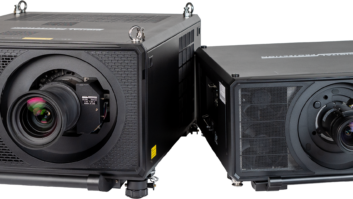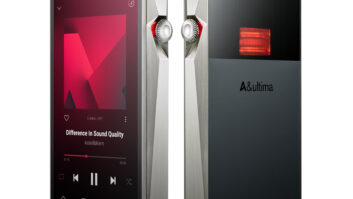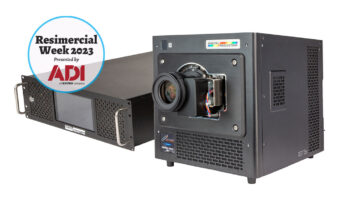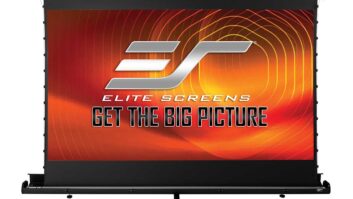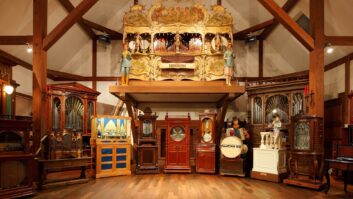Although it has been actively marketing its high-end projectors equipped with its proprietary 3D system for several years, Digital Projection gave custom installers and system integrators a demonstration in New York, Wednesday, of its Titan 1080p commercial and home theater 3-chip DLP projectors powered by a new server solution, all using the company’s proprietary approach to active-shutter 3D technology.

Digital Projection’s Bill Gillette, left, and Jeff Schneider demonstrate the one of the company’s Titan 3-chip DLP 3D projectors running off of a new Dimension Server for 3D and 2D media.
The projectors, which are available now, were designed to deliver 1080p high definition images at 120Hz refresh rates – 60Hz per eye. Alternately, if video is delivered at 24p, the system can use triple flash to achieve a 144Hz refresh rate, explained Jeff Schneider, Digital Projection Northeast and Midwest sales manager.
“It’s as powerful as a DLP cinema projector as far as refresh rates is concerned, but we can play back any 3D media and it’s available in a lot of brightness levels,” he added.
In addition to supporting the latest 3D Blu-ray active-shutter formats, the server and projectors can be configured for a wide range of 3D applications from video games to movies requiring either active or passive-shutter glasses. The system will support Digital Projection’s active-shutter system as well as the DepthQ and RealD Z-Screen, polarized passive glasses technologies.
Using polarized glasses viewers lose about 75 to 80 percent of the brightness output of the projector, Schneider explained, while those viewing 3D through the active-shutter system lose about 60 percent of the brightness output.
New in the setup is the Dimension Server ($45,000 suggested retail), which is a Windows 7 based system with support for 3D signal playback. It will provide on-board storage (1TB hard drive is included but can be expanded up to 3TBs), a stereoscopic player, optical disc drive and real-time conversion of 2D DVD source material to 3D. Video is enabled with a high-end Nvidia card.
Also included with the Dimension Server is an IR emitter and active-shutter glasses in counts of eight or 12 pairs. The company is using Xpand and RealD active shutter glasses for the system, Schneider said.
Digital Projection’s 3D partner Mechdyne, which is a specialist in stereoscopic 3D advanced playback solutions, helped to develop the server software platform, Schneider said.
The server and projectors are being upgraded to support the new Blu-ray 3D standard, added Bill Gillette, Digital Projection senior applications engineer.
“We are ready today with frame-sequential 3D, but we are following up with the more involved Blu-ray standard,” Gillette said, adding that the company is waiting for more players and media supporting the standard to arrive.
Both 3D and 2D images can be projected effectively on any surface using the Titan 3D projection systems, and offer a nearly 180-degree viewing angle, provided the viewer doesn’t step outside the IR emitter range.
The flagship commercial Titan 1080p Dual 3D (dual lamps) models sell for between $55,000 and $75,000 depending on the brightness configuration. The top of the line version will produce up to 9,000 lumens of brightness and a 2,500:1 contrast ratio.
The virtually identical-looking Titan 1080p Reference Home Cinema models sell for between $65,000 and $85,000 depending on the configuration and will produce up to 6,000 lumens of brightness at a 5,000:1 contrast ratio. The home cinema models, which include a lens in the package price, offer a significant reduction in projector noise from the commercial systems, he said.
Digital Projection’s 3D solution adds to the projectors, 120Hz 3D-ready HDMI video inputs, supporting software and an electronics hardware module, which the company code named “Straight Shot” because it by-passes a lot of the internal electronics enabling half a frame or less of latency.
The added cost for the 3D capability in the projectors is $15,000 in commercial models and $20,000 in the residential versions, Schneider said.
Models with different maximum brightness output are also available depending on the application.
Both models use three 0.95 Texas Instruments’ DLP DMD chips and UHP bulbs.
“What we find with 3D is the larger the screen, the better the experience,” Schneider said. “So, yes, you can get a 50- or 60-inch 3D flat panel set today, but with the projector approach the sky’s the limit.”
Nevertheless, Gillette said that even with all the hype for 3D in recent months, the company expects 3D to be only “a special application” in its overall home theater projector business.
Schneider said the advantage to Digital Projection’s approach to 3D over competitive high-end home cinema front projector systems using dual projectors is first and foremost simplicity of installation and consistency of image quality.
“To dual converge projectors is a real science, an art form,” he explained. “You have to really know exactly what you are doing and hope that you don’t have any problems with your lensing. If there’s one difference in the lens design or manufacturing you will never be able to get a perfect over-layered image, and if you want a 2:35:1 to 1.78:1 aspect ratio, there is no way you could do that using an anamorphic lens and a double-stack of projectors.”
